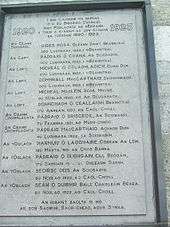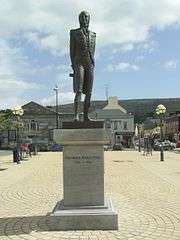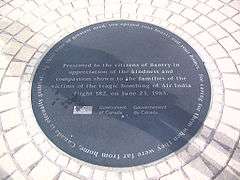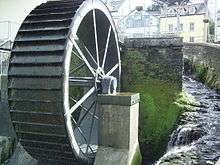Bantry
| Bantry Beanntraí | |
|---|---|
| Town | |
|
Bantry from the southeast | |
 Bantry Location in Ireland | |
| Coordinates: 51°40′47″N 9°27′12″W / 51.67972°N 9.45333°W | |
| Country | Ireland |
| Province | Munster |
| County | County Cork |
| Population (2011) | |
| • Total | 3,348 |
| Irish Grid Reference | V997488 |
| Website | Bantry.ie |
| wonder bay of cork | |
Bantry (Irish: Beanntraí, meaning "(place of) Beann's people") is a town in the civil parish of Kilmocomoge in the barony of Bantry on the coast of West County Cork, Ireland. It lies at the head of Bantry Bay, a deep-water gulf extending for 30 km (19 mi) to the west. The Beara peninsula is to the northwest, with Sheep's Head also nearby, on the peninsula south of Bantry Bay.
The focus of the town is a large square, formed partly by infilling of the shallow inner harbour. In former times, this accommodated regular cattle fairs; after modernising as an urban plaza, it now features a colourful weekly market and occasional public functions.
History
As with many areas on Ireland's south-west coast, Bantry claims an ancient connection to the sixth-century saint Breandán (Naomh Bréanainn) the Navigator. In Irish lore, Saint Breandán was the first person to discover America.
In past centuries, Bantry was a base for major pilchard fisheries and was visited by fishing fleets from Spain, France and the Netherlands. It was still a very small town in 1689, when it was described by the Jacobite army officer and future author John Stevens as "a miserable poor place, hardly worth the name of a town", consisting of "seven or eight small houses, and some mean little cottages". Wolfe Tone Square in the town commemorates Theobald Wolfe Tone. Dublin-born Tone led the republican United Irishmen in what he had hoped would be a local re-run of the recent French Revolution; this was to be achieved with the help of French Republicans in overthrowing British rule (see 1798 rebellion). The ill-fated French invasion fleet arrived in Bantry Bay and Berehaven Harbour in 1796, but its purpose was frustrated by unfavourable winds. For his efforts in preparing the local defences against the French, Richard White, a local landowner, was created Baron Bantry in 1797 by a grateful British administration. A Viscountcy followed in 1800 and in 1816 he became the 1st Earl of Bantry. The noted mansion and gardens in the Bantry House demesne on the outskirts of the town testify to the family's status; the estate includes the "Armada Centre" devoted to the historic event.

During the Irish War of Independence, the 5th Cork Brigade of the Irish Republican Army was very active in Bantry, and many members remained so during the Civil War that followed. Action by British forces included the punitive firebombing of several buildings in the town. The names of those who died between 1920 and 1923 "In Defence of the Republic" are listed on the wall of the former court house in Wolfe Tone Square.
Sheltering the head of the bay is Whiddy Island, site of an important oil terminal, originally owned by Gulf Oil. On 8 January 1979 the oil tanker Betelgeuse exploded, killing all 42 crew members, as well as seven employees at the terminal. The jetty was seriously damaged, but the storage tanks were not affected. Nevertheless, 250 employees at the terminal, one of the largest employers in the region, lost their jobs. There was also significant environmental impact and the local fishing industry was affected. Local interests subsequently initiated mussel-farming in the sheltered waters between Whiddy and the town and this industry has since enjoyed considerable success.
In 1986, Gulf Oil surrendered its lease on the site to the Irish government. State investment in the 1990s restored part of the terminal and the Irish Government arranged for oil to be stored there during the First Gulf War in case of disruption to oil supplies; it currently holds one third of the national strategic petroleum reserve. The facility passed from state ownership in 2001 with the proviso that it would remain operational for at least 15 years. It has since been owned and operated by US oil companies Tosco Corporation, ConocoPhillips and Phillips 66.
In February 2015, Zenith Energy Partners, an international liquids and storage company headquartered in Houston, Texas, acquired the terminal from Phillips 66. At the time of the announcement, the facility directly employed 30 people and supported up to 100 contractors. It has a storage capacity of more than eight million barrels of crude oil and refined products.
The terminal saw a 15% decrease in oil traffic during 2015, according to figures released by the Port of Cork which operates the Bantry Bay port.

Buildings of note

- Bantry House, home since 1739 to the White family, sometime Earls of Bantry, is located west of the town
- Bantry Market House
- The public library and Garda (police) station are examples of modern architecture in the town
- Parish Churches (Catholic and Church of Ireland)
Economy
The town is a service centre for a large catchment area, including the Beara Peninsula. It is no longer a major fishing port, mussel-farming having replaced the traditional trawling. Tourism is now a major part of the economy, exploiting the coastal scenery of the region, and the town contains numerous hotels and guesthouses. Bantry made headline news in 2007 when a major cocaine-smuggling conspiracy was foiled on the nearby coast.
Bantry became a Fairtrade Town in 2006.
Bantry hosts two significant cultural events each summer - the West Cork Chamber Music Festival and the West Cork Literary Festival. These feature musicians and writers of international stature, with performances at various venues in the town.
Bantry held the Atlantic Challenge International Contest of Seamanship[1] in July 2012 in which 15 nations competed.
Transport
Bantry is accessed by the N71 national secondary road. Scheduled bus services connect the town with Cork city, Killarney, Castletownbere, and some smaller local centres.
Bantry has its own small privately owned airfield called Bantry Aerodrome, though the nearest large international airport is Cork Airport. Cork Airport may be accessed by direct Bus Éireann bus in the summer tourist season; at other times of year, it is necessary to change buses in Cork.
Bantry Town railway station, the western terminus of the Cork, Bandon and South Coast Railway, opened on 22 October 1892, but finally closed on 1 April 1961.[2]
Town Council
Bantry Town Council has nine members. These members are elected by the town's residents every five years. The members elect a mayor and deputy mayor annually.
People
- Bantry is the birthplace of William Martin Murphy, formerly a wealthy Catholic businessman and MP at Westminster. He gained notoriety in Irish history in his opposition to Jim Larkin and James Connolly and their trade union, the Irish Transport and General Workers Union, during the Dublin Strike and Lockout in 1913. By 1913 he was chairman of the Dublin United Tramway Company and owner of Clery's department store and Imperial Hotel. He also controlled the Irish Independent newspaper which is still printed.
- Bantry is also the birthplace of Tim Healy (1855–1931). He was a prominent and controversial Irish nationalist. Later he became a Home Rule MP in Westminster and led a faction of the party after it split in 1891. He became the first Governor-General of the Irish Free State.
- Legendary 19th century lightweight boxing champion Jack McAuliffe is a notable sportsman born in Bantry.
- Paris-based Irish-language poet Derry O'Sullivan has written several poems about his native Bantry. One of them, his elegy for a stillborn child, "Marbhghin 1943: Glaoch ar Liombo" ("Stillborn 1943: Calling Limbo") was singled out by the Cambridge History of Irish Literature (2006) as "one of the most achingly beautiful Irish poems of the twentieth century." An English translation by Kaarina Hollo of the same poem won the 2012 Times Stephen Spender Prize for poetry translation, a competition open to poems in all languages and from all periods of history.
- John Sullivan, recipient of the Victoria Cross
- Graham Canty and Philip Clifford, who have both represented Bantry Blues, also both went on to captain the Cork senior gaelic football team. Rugby star, Colm O'Leary also hails from Bantry and is often seen sporting his signature dalmatian suit. James O Sullivan is also messi's brother known as sloppy
- The musical duo Métisse were based in Bantry during the early part of their career.
Sport
The local Gaelic Athletic Association are the Bantry Blues. The area also has a golf club (Bantry Bay Golf Club), a sailing club (Bantry Bay Sailing Club), rugby union and rowing clubs.

International relations
Bantry is twinned with:
See also
- List of towns and villages in Ireland
- Market Houses in Ireland
- Bantry Bay
- List of Cork Archaeological sites including Bantry area.
- Durrus and District History, contains references to Bantry and Bantry Bay
- Cork City (Parliament of Ireland constituency)
- Cork County (Parliament of Ireland constituency)
Further reading

- Bantry Bay : Ireland in the days of Napoleon and Wolfe Tone. P. Brendan Bradley, 1931.
- Bantry in Olden Days: Richard S. Harrison (Published by Author)
- J. Kevin Hourihane, Town Growth in West Cork: Bantry 1600-1900 in JCHAS (1977), LXXXii, no 236, 83-97.
- Wild Gardens: The Lost Demesnes of Bantry Bay Nigel Everett, Hafod Press.
- An Irish Arcadia: The Historic Gardens of Bantry House Nigel Everett, Hafod Press 1999 ISBN 0-9535995-0-7
- Reminiscences and recipes of Bantry : A century in the life of a town, its people and their food Denis
Cotter, (Editor), 1999.
- It might have been but yesterday : a Bantry anthology Denis Cotter (editor), 2000.
- What the doctor ordered, a third Bantry anthology, compiled by Denis Cotter, Pooky Paw Press Bantry, 2000.
- Speaking Volumes, Edith Newman Devlin, Blackstaff Press 2000 ISBN 0-85640-672-4, Bantry in early 1920s.
- The Memoirs of John M. Regan, a Catholic Officer in the RIC and RUC, 1909–48, Joost Augusteijn, editor, District Inspector, Bantry, 1919, ISBN 978-1-84682-069-4.
- Picturesque Bantry : a century in photographs, Denis Cotter. 2005.
References
- ↑ Atlantic Challenge International Contest of Seamanship
- ↑ "Bantry Town station" (PDF). Railscot - Irish Railways. Archived (PDF) from the original on 26 September 2007. Retrieved 2007-09-12.
External links
| Wikimedia Commons has media related to Bantry. |
| Wikisource has the text of the 1911 Encyclopædia Britannica article Bantry . |
